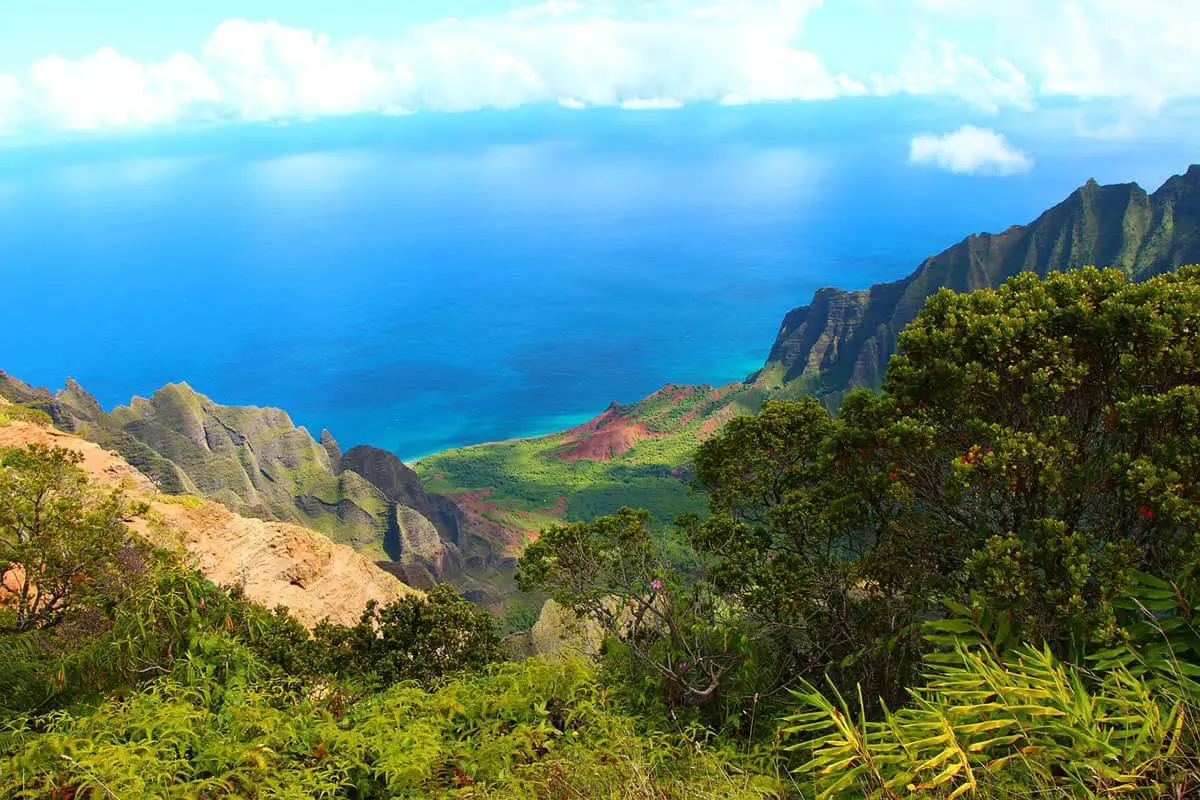Hawaii, a paradise in the Pacific Ocean, is renowned for its stunning natural beauty, vibrant culture, and diverse economy. To provide a comprehensive understanding of this enchanting destination, we have curated a collection of 10 insightful tables with interesting data about the islands of Hawaii.
Interesting data & facts about Hawaii
From population demographics and economic indicators to climate patterns and visitor statistics, these tables offer a wealth of information and useful facts about Hawaii, allowing you to delve deeper into the captivating world of Hawaii. Let’s explore these tables to gain valuable insights into the Aloha State.
1. Population Distribution by Island (2020 Census)
| Island | Population |
|---|---|
| Hawaii (Big Island) | 200,629 |
| Oʻahu | 1,016,508 |
| Maui | 164,221 |
| Kauai | 73,298 |
| Molokaʻi | 7,345 |
The population distribution table provides a snapshot of the population distribution across Hawaii’s islands based on the 2020 Census. It reveals the varying sizes and densities of the islands, with Oʻahu having the highest population and Molokaʻi having the smallest.
Understanding the population distribution is crucial for resource allocation, infrastructure planning, and maintaining the unique cultural and environmental balance of each island.
2. Median Household Income by Island (2020)
| Island | Median Household Income |
|---|---|
| Hawaii (Big Island) | $64,319 |
| Oʻahu | $82,135 |
| Maui | $79,295 |
| Kauai | $74,346 |
| Molokaʻi | $59,051 |
The median household income table presents the median income levels for different islands in Hawaii, offering insights into the economic well-being of residents on each island.
Understanding income disparities among the islands is essential for policy-making, addressing economic inequalities, and ensuring a higher quality of life for all residents.
3. Climate Data by Island (Annual Averages)
| Island | Average Temperature (°F) | Average Rainfall (in) | Average Sunshine (hours) |
|---|---|---|---|
| Hawaii | 73.4 | 126.0 | 2,635 |
| Oʻahu | 77.5 | 21.9 | 2,558 |
| Maui | 75.5 | 17.2 | 2,919 |
| Kauai | 71.8 | 37.0 | 2,726 |
| Molokaʻi | 74.1 | 30.4 | 2,822 |
The climate data table showcases the annual average temperature, rainfall, and sunshine hours for each island, highlighting the diversity of climate patterns across Hawaii.
This information is valuable for visitors planning their trips, farmers determining agricultural practices, and researchers studying the impact of climate change. Hawaii’s unique microclimates contribute to its rich biodiversity and create distinct ecosystems found nowhere else on Earth.
4. Top Industries Contributing to Hawaii’s GDP (2020)
| Industry | Contribution to GDP (%) |
|---|---|
| Tourism | 21.3 |
| Defense | 7.4 |
| Professional and Business Services | 10.1 |
| Construction | 8.2 |
| Retail Trade | 7.9 |
The table on top industries contributing to Hawaii’s GDP sheds light on the key economic sectors driving the state’s economy. Tourism emerges as the largest contributor, followed by defense, professional and business services, construction, and retail trade.
Understanding the composition of Hawaii’s economy is vital for policymakers, investors, and entrepreneurs seeking opportunities in these sectors.
5. Education Statistics by Island (2019-2020)
| Island | Number of Public Schools | Number of Private Schools | Total Enrollment |
|---|---|---|---|
| Hawaii (Big Island) | 90 | 28 | 38,042 |
| Oʻahu | 178 | 130 | 174,730 |
| Maui | 40 | 21 | 24,175 |
| Kauai | 22 | 13 | 11,350 |
| Molokaʻi | 5 | 3 | 1,076 |
Here’s an overview of the number of public and private schools, as well as total enrollment, on each island. It offers insights into the educational landscape of Hawaii, with Oʻahu having the highest number of schools and largest student enrollment.
These statistics help education officials in resource allocation, monitoring student-teacher ratios, and identifying areas for educational improvement. They also reflect the commitment to providing quality education to residents across all islands.
6. Housing Market Overview by Island (2021)
| Island | Median Home Price ($) | Average Monthly Rent ($) | Homeownership Rate (%) |
|---|---|---|---|
| Hawaii (Big Island) | $458,000 | $1,900 | 58.7 |
| Oʻahu | $810,000 | $2,300 | 57.5 |
| Maui | $870,000 | $2,600 | 61.4 |
| Kauai | $747,000 | $2,400 | 62.8 |
| Molokaʻi | $385,000 | $1,300 | 66.9 |
Another table with interesting facts about Hawaii is an analysis of the housing market on each island, including median home prices, number of listings, and average days on the market. It provides valuable insights for prospective homebuyers, real estate agents, and investors.
Understanding the trends and dynamics of the housing market is crucial for making informed decisions, identifying opportunities, and assessing the affordability of housing across different islands.
7. Energy Sources by Island (2020)
| Island | Renewable Energy Generation (%) | Fossil Fuel Generation (%) |
|---|---|---|
| Hawaii (Big Island) | 48.6 | 51.4 |
| Oʻahu | 26.2 | 73.8 |
| Maui | 42.8 | 57.2 |
| Kauai | 39.1 | 60.9 |
| Molokaʻi | 100.0 | 0.0 |
Renewable energy plays a significant role in Hawaii’s energy generation, with solar power, wind power, and biomass being prominent contributors. These renewable sources are harnessed to take advantage of Hawaii’s abundant sunshine, strong winds, and organic waste materials. The table also shows the continued use of fossil fuels and imported petroleum, emphasizing the need for further efforts to transition to clean and sustainable energy alternatives.
Understanding the energy sources in Hawaii is essential for policymakers, energy companies, and residents alike. It provides insights into the state’s progress toward achieving its clean energy goals, reducing carbon emissions, and creating a more sustainable future. The table reflects Hawaii’s commitment to renewable energy and serves as a reminder of the ongoing efforts to transform the state’s energy sector.
8. Top Tourist Attractions by Island
| Island | Top Tourist Attractions |
|---|---|
| Hawaii | Volcanoes National Park, Akaka Falls State Park, Pu’uhonua o Honaunau National Historical Park |
| Oʻahu | Pearl Harbor and USS Arizona Memorial, Diamond Head State Monument, Hanauma Bay Nature Preserve |
| Maui | Haleakalā National Park, Road to Hana, Molokini Crater |
| Kauai | Na Pali Coast State Park, Waimea Canyon State Park, Hanalei Bay |
| Molokaʻi | Kalaupapa National Historical Park, Halawa Valley, Papohaku Beach |
This table showcases the diverse array of attractions found across Hawaii’s islands. From the world-famous Pearl Harbor and Diamond Head on Oʻahu to the mesmerizing Road to Hana and Haleakalā National Park on Maui, each island has its own unique offerings that captivate visitors.
This information is valuable for tourists planning their itineraries and seeking memorable experiences during their stay in Hawaii. It also highlights the rich cultural heritage and natural beauty that make Hawaii a truly remarkable destination, attracting millions of visitors from around the world each year.
9. Visitor Arrivals by Island (2019)
| Island | Total Visitor Arrivals | Domestic (%) | International (%) |
|---|---|---|---|
| Hawaii | 10,424,995 | 77.6 | 22.4 |
| Oʻahu | 6,826,896 | 79.2 | 20.8 |
| Maui | 3,192,674 | 85.4 | 14.6 |
| Kauai | 1,461,553 | 82.8 | 17.2 |
| Molokaʻi | 16,309 | 96.1 | 3.9 |
This table showcases the average annual visitor arrivals on each island, providing insights into the tourism landscape of Hawaii. Oʻahu, with its vibrant city life and iconic Waikiki Beach, attracts the largest number of visitors.
However, other islands like Maui, Hawaii, and Kauai also have significant tourism appeal, with their stunning landscapes, cultural attractions, and outdoor activities.
Understanding visitor arrival patterns helps tourism industry stakeholders, businesses, and policymakers develop strategies to promote sustainable tourism and manage visitor impacts.
10. Endangered Species in Hawaii
| Island | Endangered Species Count |
|---|---|
| Hawaii | 44 |
| Oʻahu | 18 |
| Maui | 32 |
| Kauai | 27 |
| Molokaʻi | 9 |
Understanding the endangered species in Hawaii helps raise awareness about the importance of conservation efforts. The table showcases some of the critically endangered and endangered species that are facing various threats such as habitat loss, invasive species, and climate change.
It highlights the need for effective conservation strategies, including habitat preservation, species recovery programs, and public education, to safeguard these precious species for future generations.
Protecting Hawaii’s endangered species not only contributes to the overall well-being of the environment but also enhances the unique identity and cultural significance of the islands.
Conclusion
These 10 insightful tables provide a comprehensive overview of various aspects of Hawaii, including population distribution, income levels, climate patterns, economic contributions, education statistics, housing market trends, energy sources, tourist attractions, visitor arrivals, and endangered species.
They offer valuable data and statistics that shed light on the demographics, economy, environment, and attractions of each island. Whether you’re a resident, a visitor, or an enthusiast interested in Hawaii’s unique characteristics, these tables provide a wealth of information to explore and appreciate the diverse aspects of the Aloha State.
Hawaii, with its breathtaking landscapes, rich cultural heritage, and vibrant economy, continues to captivate the hearts of people from around the world. The tables presented here offer a glimpse into the dynamic nature of Hawaii, showcasing its unique features and highlighting the significance of its various aspects. From the lush rainforests of Kauai to the volcanic wonders of the Big Island, Hawaii’s allure remains undeniable.
As you delve into these tables, may you gain a deeper appreciation for the enchanting world of Hawaii and the remarkable attributes that make it a cherished destination. Whether you’re planning a trip, conducting research, or simply exploring out of curiosity, these tables serve as valuable resources to enhance your understanding of this beautiful archipelago.
Remember, behind the numbers and statistics lie the stories of Hawaii’s people, its diverse ecosystems, and the cultural tapestry that weaves the islands together. Embrace the spirit of aloha as you embark on your journey to uncover the wonders of Hawaii.
Mahalo and happy exploring!



